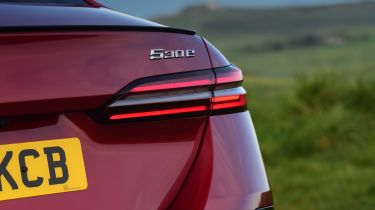BMW 5 Series - MPG, emissions & running costs
Running costs for the BMW 5 Series remain competitive, but the EV i5 will be better for company car drivers

Fuel economy for the BMW 5 Series is competitive with its rivals. The entry-level 520i petrol engine outdoes its Mercedes E-Class equivalent by offering up to 48.7mpg and emissions of 132g/km. Based on our experience testing plug-in hybrid models, you’re unlikely to get anything like the 470.8mpg quoted for the 530e or the 353.1mpg for the 550e, even with regular charging.
The 5 Series is no longer offered in the UK with a diesel engine, so those needing a car to tackle lots of motorway miles will need to defect to the Mercedes E-Class, which still offers a 220d model that will do over 55mpg, or a powerful 450d that’ll average around 45mpg. All 5 Series models come with a sizeable 60-litre fuel tank.
|
Model |
MPG |
CO2 |
Insurance group |
|
5 Series 520i M Sport |
48.7mpg |
132g/km |
35E |
|
5 Series 530e M Sport |
470.8mpg |
14g/km |
39E |
|
5 Series 550e xDrive M Sport |
353.1mpg |
19g/km |
44E |
Electric range, battery life and charge time
Both the 530e and 550e plug-in hybrid versions of the BMW 5 Series use a 22.1kWh battery pack (19kWh useable), which provides around 63 miles of range in the 530e, and 56 miles of range in the 550e. Using a standard 7.4kW home wallbox charger, it should take around 3.5 hours to charge a flat battery.
The equivalent Mercedes E-Class plug-in hybrid has a larger 25.4kWh useable battery and 70 miles of electric range. The E-Class can also be rapidly charged, with a 10-80 per cent top-up time of around 20 minutes – although you’ll find this an expensive way of running a plug-in hybrid.
Tax
Due to every version of the BMW 5 Series costing well over £40,000 when new, there will be a luxury car surcharge applied to all models from the second year the vehicle is taxed, up until it is six years old.
Used - available now

2020 BMW
5 Series
91,150 milesAutomaticPetrol2.0L
Cash £16,695
2020 BMW
5 Series
5,330 milesAutomaticPetrol2.0L
Cash £21,063
2023 BMW
5 Series
54,520 milesAutomaticPetrol2.0L
Cash £21,000
2023 BMW
5 Series
28,200 milesAutomaticDiesel2.0L
Cash £29,883Company car drivers will benefit from lower Benefit-in-Kind (BiK) taxation with the plug-in hybrid 530e and 550e compared with the petrol 520i. Both plug-in hybrid versions of the 5 Series get into the eight per cent BiK band, but it’s worth pointing out that some versions of the Mercedes E-Class plug-in hybrid get into the lower five per cent BiK band.
If company car drivers want to save even more money, the dealer will happily point them in the direction of the all-electric BMW i5, which we’ve covered in a separate review.
Insurance groups
Insurance should be more affordable than the equivalent Mercedes E-Class, because the 5 Series range starts off in group 35 for the 520i petrol, before going up to group 44 for the fastest 550e plug-in hybrid. The E-Class range in contrast starts in group 41, before ending up in the highest group 50 rating for the plug-in hybrids – the same as its fastest AMG high-performance models.
Depreciation
According to our expert data, the BMW 5 Series is on par with the Mercedes E-Class, and should maintain between 43 per cent of its resale value for a 550e M Sport Pro with both the Technology and Comfort packs, and 51 per cent for an entry-level 520i M Sport.
By way of interesting comparison, the all-electric BMW i5 is predicted to maintain more of its value over the same period, between 52 and 55 per cent.








